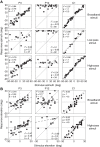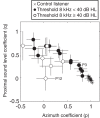Single-sided deafness and directional hearing: contribution of spectral cues and high-frequency hearing loss in the hearing ear
- PMID: 25071433
- PMCID: PMC4082092
- DOI: 10.3389/fnins.2014.00188
Single-sided deafness and directional hearing: contribution of spectral cues and high-frequency hearing loss in the hearing ear
Abstract
Direction-specific interactions of sound waves with the head, torso, and pinna provide unique spectral-shape cues that are used for the localization of sounds in the vertical plane, whereas horizontal sound localization is based primarily on the processing of binaural acoustic differences in arrival time (interaural time differences, or ITDs) and sound level (interaural level differences, or ILDs). Because the binaural sound-localization cues are absent in listeners with total single-sided deafness (SSD), their ability to localize sound is heavily impaired. However, some studies have reported that SSD listeners are able, to some extent, to localize sound sources in azimuth, although the underlying mechanisms used for localization are unclear. To investigate whether SSD listeners rely on monaural pinna-induced spectral-shape cues of their hearing ear for directional hearing, we investigated localization performance for low-pass filtered (LP, <1.5 kHz), high-pass filtered (HP, >3kHz), and broadband (BB, 0.5-20 kHz) noises in the two-dimensional frontal hemifield. We tested whether localization performance of SSD listeners further deteriorated when the pinna cavities of their hearing ear were filled with a mold that disrupted their spectral-shape cues. To remove the potential use of perceived sound level as an invalid azimuth cue, we randomly varied stimulus presentation levels over a broad range (45-65 dB SPL). Several listeners with SSD could localize HP and BB sound sources in the horizontal plane, but inter-subject variability was considerable. Localization performance of these listeners strongly reduced after diminishing of their spectral pinna-cues. We further show that inter-subject variability of SSD can be explained to a large extent by the severity of high-frequency hearing loss in their hearing ear.
Keywords: azimuth; head-shadow effect; mold; single-sided deaf(ness); spectral pinna-cues.
Figures






References
-
- Agterberg M. J., Snik A. F., Hol M. K., Van Wanrooij M. M., Van Opstal A. J. (2012). Contribution of monaural and binaural cues to sound localization in patients with unilateral conductive hearing loss; improved directional hearing with a bone-conduction device. Hear. Res. 286, 9–18 10.1016/j.heares.2012.02.012 - DOI - PubMed
-
- Arndt S., Aschendorff A., Laszig R., Beck R., Schild C., Kroeger S., et al. (2011). Comparison of pseudobinaural hearing to real binaural hearing rehabilitation after cochlear implantation in patients with unilateral deafness and tinnitus. Otol. Neurotol. 32, 39–47 10.1097/MAO.0b013e3181fcf271 - DOI - PubMed
LinkOut - more resources
Full Text Sources
Other Literature Sources
Research Materials
Miscellaneous

